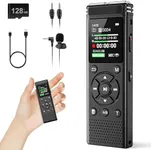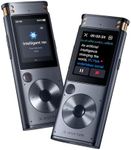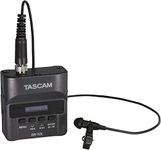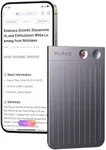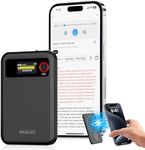Buying Guide for the Best Voice Recorder For Students
Choosing the right voice recorder for students can greatly enhance their learning experience by allowing them to capture lectures, discussions, and personal notes. When selecting a voice recorder, it's important to consider several key specifications to ensure it meets your needs. Understanding these specs will help you make an informed decision and find the best fit for your requirements.Recording QualityRecording quality refers to the clarity and detail of the audio captured by the voice recorder. This is important because higher quality recordings make it easier to understand and transcribe lectures or notes. Recording quality is often measured in bit rates (kbps) and sample rates (kHz). Higher bit rates and sample rates generally mean better quality. For students, a recorder with a bit rate of at least 128 kbps and a sample rate of 44.1 kHz is usually sufficient. If you need to capture very detailed audio, such as for music or complex discussions, consider higher values.
Storage CapacityStorage capacity determines how much audio you can store on the device. This is crucial for students who need to record long lectures or multiple sessions without frequently transferring files. Storage is typically measured in gigabytes (GB). A recorder with 4GB to 8GB of internal storage is usually adequate for most students, providing several hours of recording time. If you anticipate needing more space, look for models with expandable storage options, such as microSD card slots.
Battery LifeBattery life indicates how long the voice recorder can operate on a single charge or set of batteries. This is important for students who need to record long lectures or use the device throughout the day. Battery life can range from a few hours to over 20 hours. For most students, a recorder with at least 10 hours of battery life should be sufficient. If you have long days or limited access to charging, consider models with longer battery life or the ability to use replaceable batteries.
Microphone QualityMicrophone quality affects how well the recorder captures sound, especially in large or noisy environments. This is important for students who need to record lectures in big classrooms or busy areas. Look for recorders with built-in high-sensitivity microphones or the option to connect an external microphone. Some models offer noise reduction features, which can be beneficial in filtering out background noise. If you often record in challenging environments, prioritize models with advanced microphone technology.
PortabilityPortability refers to the size and weight of the voice recorder, which affects how easy it is to carry around. This is important for students who need to bring the recorder to different classes or study sessions. Compact and lightweight models are more convenient to carry in a backpack or pocket. Look for a balance between portability and functionality, ensuring the device is small enough to be easily transported but still offers the features you need.
Ease of UseEase of use encompasses the user interface and overall usability of the voice recorder. This is important for students who need to quickly start and stop recordings or navigate through files. Look for models with intuitive controls, clear displays, and simple file management systems. Some recorders offer voice activation features, which can automatically start recording when sound is detected. If you prefer a straightforward experience, prioritize models known for their user-friendly design.
File Format CompatibilityFile format compatibility refers to the types of audio files the recorder can save and how easily these files can be transferred and played on other devices. This is important for students who need to share recordings or use them on different platforms. Common formats include MP3 and WAV, which are widely supported and easy to work with. Ensure the recorder you choose supports formats that are compatible with your computer, smartphone, or other devices you plan to use for playback and editing.


